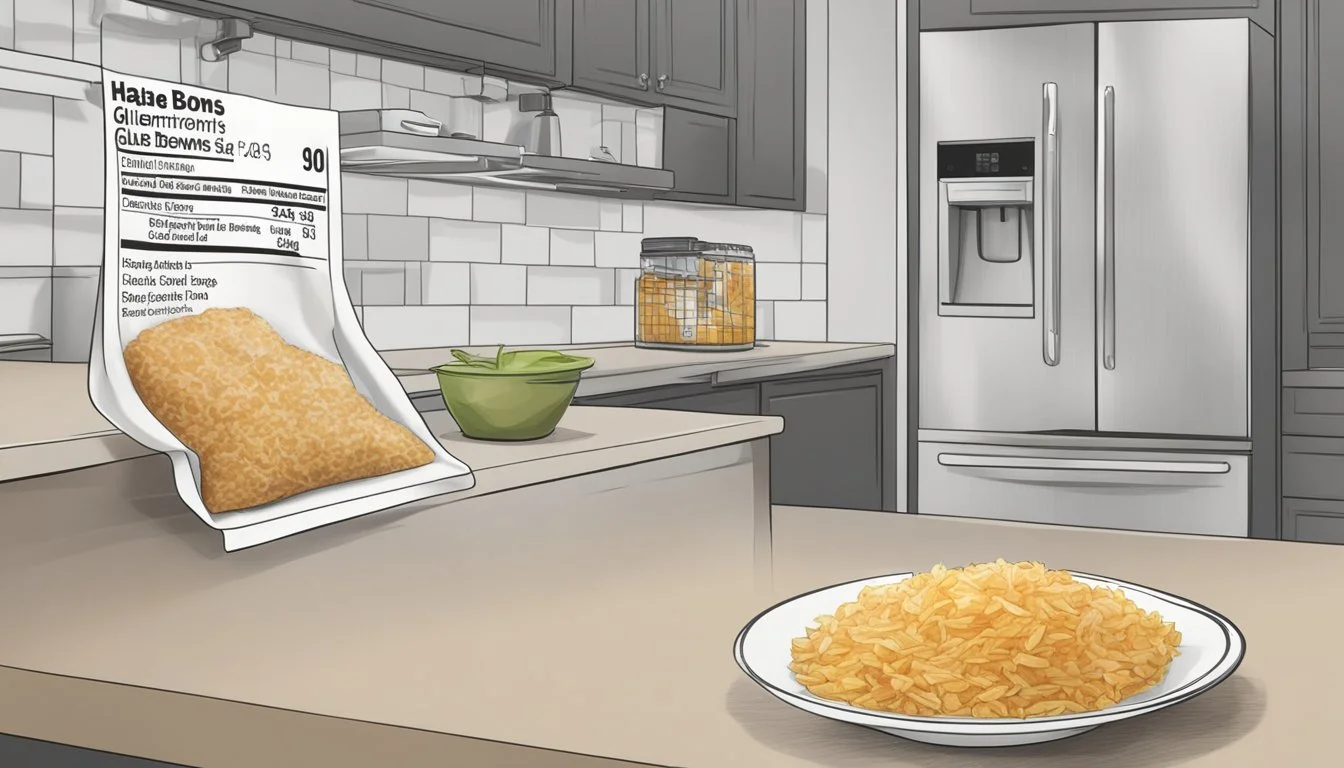How Long Do Gluten-Free Hash Browns Last?
Storage Tips and Shelf Life
Gluten-free hash browns can be a fantastic addition to meals, especially for those with celiac disease or gluten sensitivities. They are quick to prepare, versatile, and delicious. However, it's important to know how long they last to ensure both safety and optimal taste. Gluten-free hash browns typically last in the refrigerator for 3 to 5 days when stored in an airtight container. Proper storage is crucial to prevent cross-contamination with gluten-containing foods.
For those who prefer making hash browns in advance or have leftovers, freezing is an excellent option. Gluten-free hash browns can be frozen for up to three months, maintaining their flavor and texture when reheated properly. Simply cool them completely before placing them in a single layer on a baking sheet to freeze, then transfer to a freezer-safe bag.
Understanding the lifespan of gluten-free hash browns helps in meal planning and ensures that they are consumed while still fresh and safe. With the right storage techniques, you can enjoy them just as fresh as the day they were made. The key is maintaining a gluten-free environment during storage and handling to avoid cross-contamination.
Understanding Gluten-Free Hash Browns
Gluten-free hash browns are a popular breakfast staple. They are made with specific ingredients to ensure they are safe for people with celiac disease or gluten intolerance.
Defining Gluten-Free
Gluten-free means the absence of gluten, a protein found in wheat, barley, and rye. For people with celiac disease, consuming gluten can damage their intestinal lining and lead to serious health issues.
Hash browns labeled as gluten-free must be made without any gluten or gluten-containing ingredients. Additionally, strict measures must be taken to avoid cross-contamination during preparation and cooking.
Ingredients in Gluten-Free Hash Browns
The primary ingredient in gluten-free hash browns is potatoes. Potatoes are naturally gluten-free and form the basis of these crispy breakfast favorite.
Common ingredients include salt, pepper, and sometimes minced garlic for added flavor. Onions are often included for their savory taste.
To bind the mixture, a small amount of a gluten-free starch like cornstarch or all-purpose gluten-free flour can be used. Some recipes may use olive oil or ghee for frying to achieve a golden, crispy texture.
Ingredients must be certified gluten-free to ensure they are safe for those with gluten sensitivities. Proper handling and preparation are crucial to avoid cross-contamination.
Preparation Techniques
Gluten-free hash browns require thoughtful preparation to achieve a crispy texture and delicious flavor. Using the right type of potatoes, cutting them appropriately, and seasoning the hash browns are crucial steps in this process.
Choosing the Right Potatoes
Selecting the right type of potatoes is crucial for the texture of gluten-free hash browns. Russet potatoes and Yukon Gold are excellent choices.
Russet potatoes have a high starch content, which helps in achieving a crispy exterior, while Yukon Gold potatoes provide a creamier texture.
Both types allow the hash browns to maintain their shape during frying or baking. Ensure the potatoes are fresh and free of blemishes to achieve the best results.
Cutting and Shaping Hash Browns
The way the potatoes are cut significantly impacts the cooking process. For classic hash browns, shredding or grating the potatoes is common.
Use a box grater or a food processor for even shreds. Alternatively, dicing the potatoes into small cubes can provide a different texture, commonly seen in home fries.
After grating or dicing, it's essential to remove excess moisture by pressing the potatoes with a clean towel or paper towels. Forming patties or keeping them loose is a matter of personal preference, but patties can offer a more uniform cook.
Seasoning for Flavor
Proper seasoning brings out the best flavors in gluten-free hash browns. Basic seasonings include salt, black pepper, onion powder, and garlic powder.
For additional flavor, consider adding paprika or fresh herbs like parsley. An ingredients list might also include shredded Parmesan for a cheesy touch or cornstarch for extra crispiness.
Mix the seasonings thoroughly with the potatoes before cooking. This ensures even distribution and consistent flavor in every bite. Adjust the amount of seasoning based on personal taste and dietary preferences.
Cooking Methods
To achieve the perfect gluten-free hash browns, the cooking method is crucial. This section covers frying and baking techniques, detailing the steps to ensure the hash browns turn out crispy and golden brown.
Frying Hash Browns to Perfection
Frying provides a classic, crispy texture to hash browns. First, shred the potatoes and squeeze out excess moisture using a cloth or paper towel. Dry potatoes ensure crispiness.
Heat a tablespoon of vegetable oil or butter in a non-stick pan over medium-high heat. Spread the shredded potatoes evenly in the pan, pressing them down slightly with a spatula.
Cook for about 5-7 minutes until the bottom is golden brown and crispy. Flip the hash browns and cook for another 5-7 minutes. Adjust heat as necessary to avoid burning.
For enhanced flavor, season with salt and pepper during cooking. Once both sides are crispy, transfer the hash browns to a plate lined with paper towels to drain excess oil.
Baking in the Oven
Baking is a healthier option that requires less monitoring. Preheat the oven to 425°F (220°C). Line a baking tray with parchment paper to prevent sticking and facilitate easy cleanup.
Spread the shredded, dried potatoes thinly on the baking sheet, making sure they are even. Drizzle with a small amount of vegetable oil and season with salt and pepper.
Bake for about 20-25 minutes, checking occasionally. Turn the hash browns halfway through using a spatula to ensure even cooking. They should be golden brown and crispy when done.
Allow them to cool slightly on the baking tray for better texture before serving. The oven method is especially good for larger batches or when you prefer a hands-off approach.
Using these cooking methods, you can create delicious, gluten-free hash browns that are both crispy and golden brown, whether prepared in a pan or baked in the oven.
Storage and Shelf Life
Gluten-free hash browns can be stored effectively to maintain their taste and texture. Proper storage methods ensure your hash browns stay fresh and safe to eat over their intended shelf life.
Refrigerating Hash Browns
Uncooked hash browns can last in the refrigerator for 2 to 3 days.
Store them in an airtight container or a sealed plastic bag to prevent moisture loss and contamination. Label the container with the date to keep track of their freshness.
Leftover cooked hash browns should be refrigerated within two hours of cooking. Place them in a shallow container and cover tightly. Cooked hash browns will maintain their quality for about 3 to 5 days in the fridge. For best results, reheat them on a skillet to regain their crispiness.
Freezing for Longevity
Freezing extends the shelf life of gluten-free hash browns significantly.
To freeze, place uncooked or cooked hash browns on a baking sheet in a single layer and freeze until solid. Then, transfer them to airtight containers or freezer bags, removing as much air as possible to reduce freezer burn. Label each container with the freezing date.
Properly stored, frozen hash browns can last up to six months.
Reheat cooked hash browns directly from the freezer by baking or frying until tender and crispy. Freezing helps maintain the texture and flavor of the hash browns, ensuring a ready supply for quick meals.
Serving Suggestions
Gluten-free hash browns can be enjoyed in many ways, whether as the star of a breakfast plate or a tasty side dish. The following ideas will help you make the most of this versatile dish.
Breakfast Pairings
Gluten-free hash browns are perfect when paired with other breakfast staples like eggs, bacon, and ham. Serve them alongside scrambled or fried eggs for a hearty meal.
For a more elaborate brunch, consider a hash brown and cheese casserole. Parmesan or cheddar cheese melted on top gives an extra layer of flavor. Additionally, hash browns can be a great base for a breakfast burrito, wrapped with eggs, cheese, and your favorite vegetables.
For lighter options, serve hash browns with fresh fruit or a green smoothie. These pairings add a balance of nutrients and flavors to your breakfast spread.
Side Dishes and Variations
As a side dish, gluten-free hash browns complement a variety of main courses. Pair them with grilled chicken or fish to add a satisfying crunch. For a classic combo, serve them with a juicy burger instead of tater tots.
Incorporate variations to keep things interesting. Add grated cheese to the hash brown mix for a cheesy twist. For a spicier version, mix in jalapenos or chili powder. Experiment with different herbs and spices to match the flavor profile of your main dish.
For a hearty brunch option, layer hash browns, slices of ham, and melted cheese in a baking dish for a delectable hash brown casserole. This dish can feed a crowd and is easy to prepare in advance.
Nutritional Information
Gluten-free hash browns can be a nutritious addition to any meal, offering various macronutrients and essential vitamins and minerals. Understanding their nutritional profile can help you make informed dietary choices.
Macronutrient Breakdown
Gluten-free hash browns primarily consist of carbohydrates, making them a good source of energy. A typical serving (about 100 grams) contains roughly 150-200 calories.
Carbohydrates: 30-35 grams
Protein: 2-3 grams
Fat: 4-6 grams
The fat content can vary depending on the cooking method and added ingredients like oils or butter. When prepared with minimal fats, they remain relatively low in calories, making them a healthier option for those watching their caloric intake. These hash browns also contain a small amount of fiber, which aids digestion.
Vitamins and Minerals
Gluten-free hash browns are rich in various vitamins and minerals. They are notably high in potassium, with about 400-500 milligrams per serving, which supports heart and muscle function.
Vitamin C: Provides around 10-12 milligrams, aiding immune function and skin health.
Iron: Contains approximately 0.6-1.0 milligrams, essential for red blood cell production.
Additionally, these hash browns can offer small amounts of other vitamins and minerals, such as Vitamin B6 and magnesium, contributing to overall health. Including them in your diet can help meet daily nutrient requirements.







